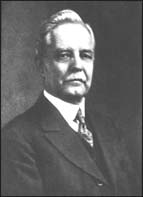-
 Physicist, Astronomer(Relativity, Astronomy, Aether)
Physicist, Astronomer(Relativity, Astronomy, Aether)Born in Ohio to Charles Webster Dewey and Vienna Pomeroy Miller, Dayton Clarence Millergraduated from Baldwin University in 1886 and obtained a doctorate in astronomy at Princeton University under Charles A. Young in 1890. Miller spent his entire career teaching astronomy at the Case School of Applied Science in Cleveland, Ohio, as head of the physics department from 1893 until his retirement in 1936. Following the discovery of X-rays by Wilhelm R?ntgen in 1895, Miller used cathode ray tubes built by William Crookes to make some of the first photographic images of concealed objects, including a bullet within a man?s limb. Active in many scientific organization, Miller was a member of the American Academy of Arts and Sciences and the American Philosophical Society. During the 1920s, he served as secretary, vice president, and president of the American Physical Society and as chairman of the division of Physical Sciences of the National Research Council. From 1931 to 1933 he was president of the Acoustical Society of America.
In 1900, he began work with Edward Morley on the detection of aether drift,[5] at the time one of the "hot" areas of fundamental physics. Following on with the basic apparatus as the earlier Michelson-Morley experiment, Miller and Morley published another null result in 1904. The experiments concerned many physicists dealing with Albert Einstein?s theory of relativity.
Miller continued with the experiment, conducting thousands of measurements and eventually developing the most accurate interferometer in the world at that time. The type of experimental apparatus Miller used was very delicate. Dayton Miller performed over 200,000 observations and experiments dealing with the aether and aether drift.[6] A second publication in 1926[7] [8] showed what appeared to be a small amount of drift, which Miller commented on at several meetings. A third, in 1933,[9] [10] continued the theme. From 1902 to 1933 Miller performed experiments producing more accurate measurements. This work was published as a positive result for the existence of an aether drift. However, the effect Miller saw was tiny. In order for it to detect aether, the properties of aether drag would have to be more pronounced. Furthermore, the measurement was statistically far from any other measurements being carried on at the time, fringe shifts of about 0.01 were being observed in many experiments, while Miller?s 0.08 was not duplicated anywhere else -- including Miller?s own 1904 experiments with Morley, which showed a drift of only 0.015. The measurements are perfectly consistent with a fringe difference of zero -- the null result that every other experiment was recording.
Einstein was interested in this aether drift theory and acknowledged that a positive result for the existence of aether would invalidate the theory of special relativity, but commented that altitudal influences and temperatures may have provided sources of error in the findings. Miller commented:
- "The trouble with Professor Einstein is that he knows nothing about my results. ... He ought to give me credit for knowing that temperature differences would affect the results. He wrote to me in November suggesting this. I am not so simple as to make no allowance for temperature."
During the 1920s a number of experiments, both interferometry based, as in Miller?s experiment, and others using entirely different techniques, were conducted and these returned a null result as well. Even at the time, Miller?s work was increasingly considered to be a statistical anomaly, an opinion which remains true today,[11] given an ever growing body of negative results. - Wikipedia
Robert S. Shankland?s 1955 "reanalysis" of Miller?s work played a major role in posthumously discreditting it, though the remnant of dissidents who have examined it closely have found Miller?s work and interpretation above reproach. Milller?s decades-long dedication to accurate scientific measurement stands as a monument and example to physicists today.
Selected papers by Dr. Miller:
- Henry T. Eddy, Edward W. Morley, and Dayton C. Miller, "The Velocity of Light in the Magnetic Field," Physics Review, S1, V7, N5, pp. 283-295 (Dec 1898).
- Dayton C. Miller, "Ether-drift Experiments at Mount Wilson Solar Observatory," Physics Review, S2, V19, N4, pp. 407-408 (Apr 1922).
- Dayton C. Miller, "Significance of Ether-drift Experiments of 1925 at Mount Wilson," Address of the President, American Physical Society, Science, V63, pp. 433-443 (1926). A.A.A.S Prize paper.
- Dayton C. Miller, "Ether-drift Experiments at Mount Wilson in February, 1926, National Academy of Sciences, Washington (Apr 1926) {Physics Review, S2, V27, N6, pp. 812 (Jun 1926)}.
- Dayton C. Miller, "The Ether-Drift Experiment and the Determination of the Absolute Motion of the Earth," Rev. Mod. Phys., V5, N3, pp. 203-242 (Jul 1933).
- George Joos & Dayton C. Miller, "Note on the Repetition of the Michelson-Morley Experiment," Physics Review, S2, V45, N2, pp. 114 (Jan 1934).
Harvey Fletcher, "Biographical Memoir of Dayton Clarence Miller 1866-1941," National Academy of Sciences of the USA Biographical Memoirs, V23, N3, 16pp (1943).
Sparks, Lightning, Cosmic Rays: An Anectodal History of Electricity (Buy Now)
Authors

